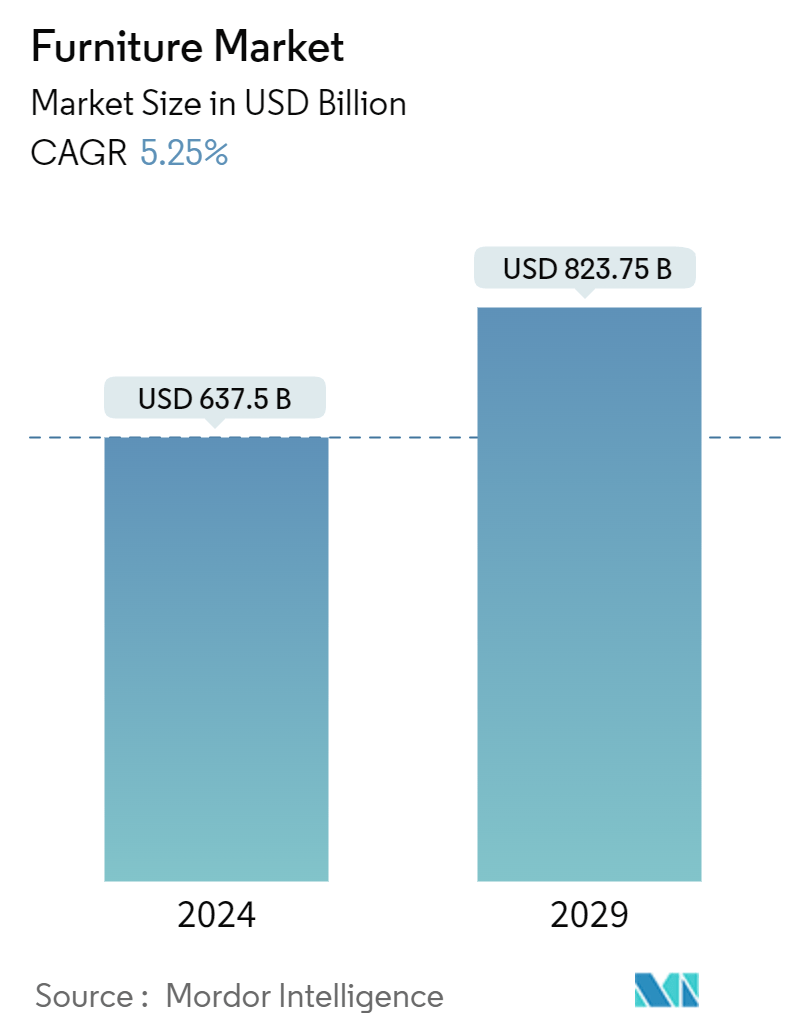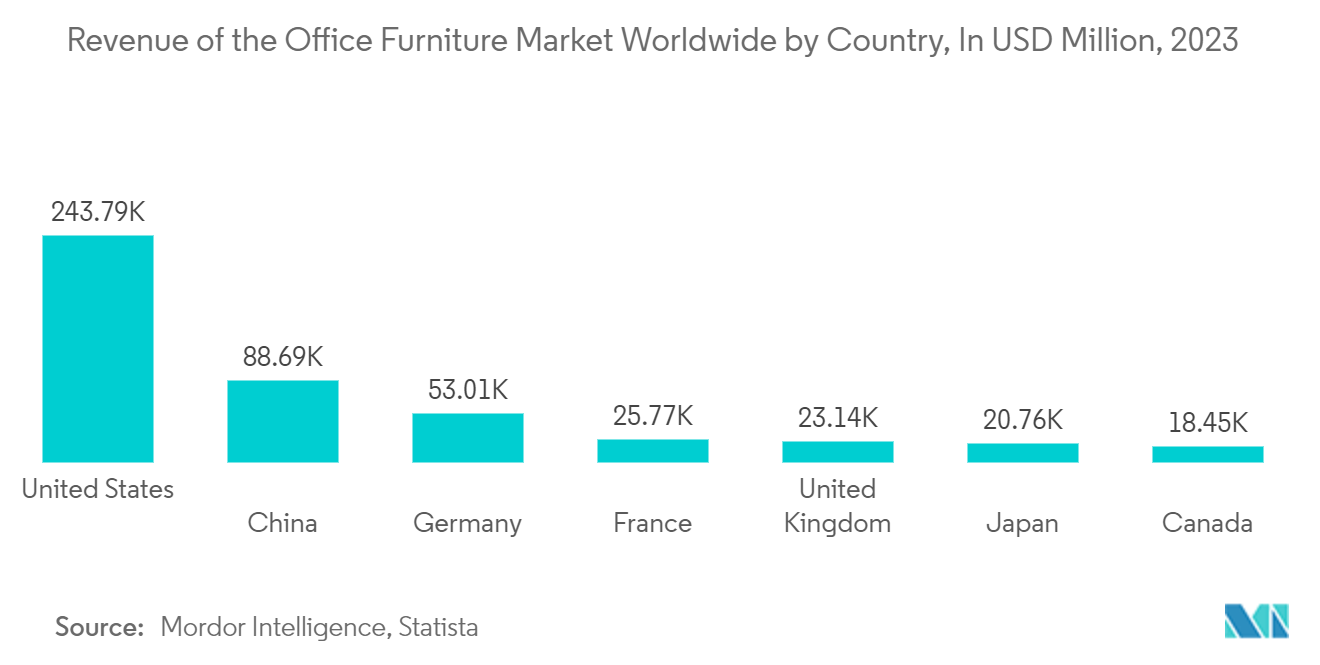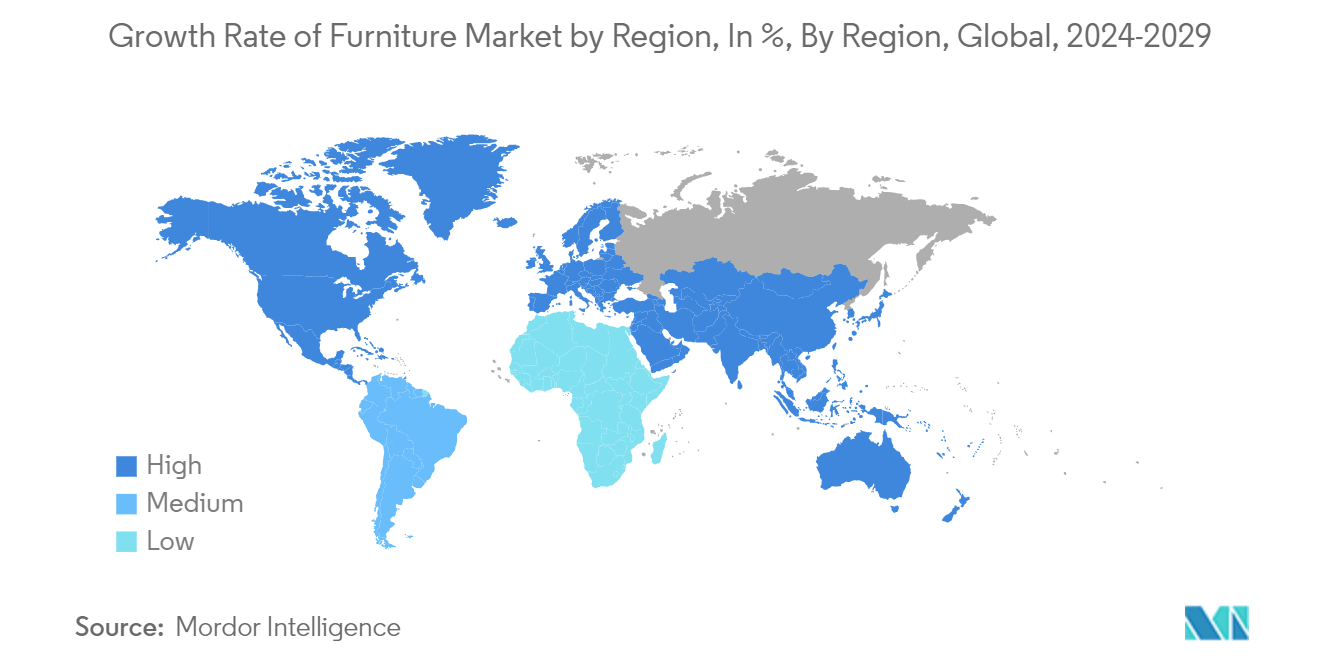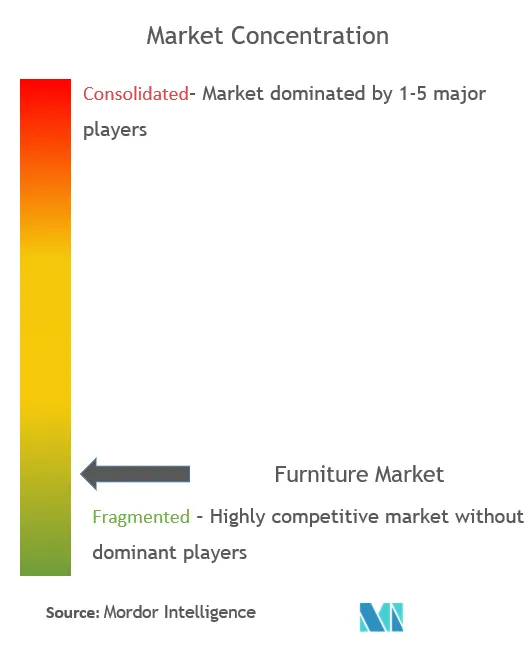Furniture Market Size

| Study Period | 2020 - 2029 |
| Market Size (2024) | USD 637.5 Billion |
| Market Size (2029) | USD 823.75 Billion |
| CAGR (2024 - 2029) | 5.25 % |
| Fastest Growing Market | Asia Pacific |
| Largest Market | North America |
Major Players
*Disclaimer: Major Players sorted in no particular order |
Furniture Market Analysis
The Furniture Market size is estimated at USD 637.5 billion in 2024, and is expected to reach USD 823.75 billion by 2029, at a CAGR of 5.25% during the forecast period (2024-2029).
The furniture industry has witnessed steady growth recently, propelled by urbanization, population expansion, increased disposable incomes, and evolving lifestyle preferences worldwide. As the furniture market size continues to expand with urbanization on the rise, especially in emerging economies, the demand for furniture for residential and commercial spaces like apartments, offices, hotels, and restaurants is expected to surge. Additionally, the real estate sector's expansion and a growing inclination toward home renovation and interior decoration are further driving the demand for furniture products.
The increasing focus on eco-friendliness and sustainability is one key trend changing the global furniture sector, significantly impacting the furniture market size. The growing consumer knowledge of environmental issues and concerns about the effects of furniture manufacturing on the environment has increased demand for eco-friendly production methods and furniture made of sustainable materials like bamboo, recycled, and reclaimed wood.
Moreover, the furniture sector is progressively using technological innovations like 3D printing, augmented reality (AR), and virtual reality (VR). With the help of these technologies, furniture producers and merchants can produce unique designs and personalized items and give customers engaging shopping experiences.
Furniture Industry Trends
Rise in Office Furniture Market
The office furniture market has experienced substantial growth recently, propelled by several key factors. The shift toward remote and flexible work arrangements has prompted a change in office design, favoring more flexible and collaborative spaces. This shift has driven up the demand for modular and adaptable office furniture. Employers are increasingly prioritizing the creation of healthier and more comfortable work environments to enhance employee well-being and productivity. This focus, a significant part of current furniture industry trends, has resulted in the adoption of ergonomic furniture and furniture that supports health and wellness initiatives.
There is also a rising awareness and demand for sustainable and environmentally friendly products in the furniture industry. Manufacturers, including some of the biggest furniture companies, are responding by incorporating eco-friendly materials and production processes, which has resonated with environmentally conscious consumers and businesses. Additionally, design trends and preferences, key components of furniture industry trends, play a significant role in shaping the office furniture market. Modern, sleek designs are particularly popular, along with customizable and modular furniture options that can accommodate different office layouts and styles.

Asia-Pacific is the Fastest-Growing Region in the Furniture Industry
Asia-Pacific is one of the largest and fastest-growing furniture markets globally, holding a significant furniture market share according to the recent furniture industry statistics. The furniture industry is fueled by economic development and urbanization rates in countries across the region. The residential furniture segment is a significant contributor to the Asia-Pacific furniture market. Demand for residential furniture is driven by factors such as new housing construction, renovation activities, and changing consumer preferences for stylish and functional furniture designs. Key product categories include living room furniture, bedroom furniture, dining room furniture, and kitchen furniture.
China, India, and Japan are among APAC's most significant furniture marketplaces, often serving as operational hubs for some of the biggest furniture companies. The distinct market dynamics, consumer tastes, and regulatory framework of each nation influence the demand and sales of furniture. There is an increasing focus on sustainability and environmentally friendly practices in the Asia-Pacific furniture market. Manufacturers are adopting sustainable materials, production processes, and recycling initiatives to meet consumer demand for eco-friendly furniture options.

Furniture Industry Overview
The furniture market is highly competitive and fragmented, with numerous manufacturers, retailers, and distributors operating across regions. The furniture market is characterized by a mix of large multinational corporations, mid-sized companies, and smaller manufacturers and retailers. Some of the biggest furniture companies in the industry include IKEA, Ashley Furniture Industries, Steelcase Inc., Herman Miller Inc., and Haworth Inc.
Furniture Market Leaders
-
Ashley Furniture Industries, Inc.
-
Inter IKEA Group
-
Herman Miller, Inc.
-
HNI Corp.
-
Steelcase Inc.
*Disclaimer: Major Players sorted in no particular order

Furniture Market News
- February 2023: Inter IKEA Group introduced three collections to encourage households to make more sustainable purchases as part of its new transitional range: Vivid Wonderland, Glorious Green, and Simple Serenity.
- September 2022: Durham Furniture Inc. partnered with Intiaro, a 3D tech company, with an emphasis on 3D strategy and visualization tools to improve the new online and shop experience.
Furniture Market Report - Table of Contents
1. INTRODUCTION
- 1.1 Study Assumptions and Market Definition
- 1.2 Scope of the Study
2. RESEARCH METHODOLOGY
3. EXECUTIVE SUMMARY
4. MARKET DYNAMICS AND INSIGHTS
- 4.1 Market Overview
-
4.2 Market Drivers
- 4.2.1 Increasing Disposable Income
- 4.2.2 Growth of E-commerce Platforms
-
4.3 Market Restraints
- 4.3.1 High Competition in the Market
- 4.3.2 Fluctuating Raw Material Prices
-
4.4 Market Opportunities
- 4.4.1 Introduction of Smart Furniture
- 4.4.2 Rise in Demand for Eco-friendly Furniture
- 4.5 Value Chain Analysis
-
4.6 Industry Attractiveness: Porter's Five Forces Analysis
- 4.6.1 Threat of New Entrants
- 4.6.2 Bargaining Power of Buyers
- 4.6.3 Bargaining Power of Suppliers
- 4.6.4 Threat of Substitutes
- 4.6.5 Intensity of Competitive Rivalry
- 4.7 Insights into Technological Advancements in the Industry
- 4.8 Impact of COVID-19 on the Market
5. MARKET SEGMENTATION
-
5.1 By Product Type
- 5.1.1 Beds
- 5.1.2 Tables
- 5.1.3 Sofas
- 5.1.4 Chairs and Stools
- 5.1.5 Others (Wardrobes, Shelves, and Cabinets)
-
5.2 By Material
- 5.2.1 Metal
- 5.2.2 Wood
- 5.2.3 Plastic
- 5.2.4 Glass
-
5.3 By Application
- 5.3.1 Residential
- 5.3.2 Commercial
-
5.4 By Distribution Channel
- 5.4.1 Home Centers
- 5.4.2 Specialty Stores
- 5.4.3 Online Stores
-
5.5 By Geography
- 5.5.1 North America
- 5.5.1.1 United States
- 5.5.1.2 Canada
- 5.5.1.3 Mexico
- 5.5.1.4 Rest of North America
- 5.5.2 Europe
- 5.5.2.1 United Kingdom
- 5.5.2.2 Germany
- 5.5.2.3 France
- 5.5.2.4 Russia
- 5.5.2.5 Italy
- 5.5.2.6 Spain
- 5.5.2.7 Rest of Europe
- 5.5.3 Asia-Pacific
- 5.5.3.1 India
- 5.5.3.2 China
- 5.5.3.3 Japan
- 5.5.3.4 Australia
- 5.5.3.5 Rest of Asia-Pacific
- 5.5.4 South America
- 5.5.4.1 Brazil
- 5.5.4.2 Argentina
- 5.5.4.3 Rest of South America
- 5.5.5 Middle East and Africa
- 5.5.5.1 United Arab Emirates
- 5.5.5.2 South Africa
- 5.5.5.3 Rest of Middle East and Africa
6. COMPETITIVE LANDSCAPE
- 6.1 Market Concentration Overview
-
6.2 Company Profiles
- 6.2.1 Ashley Furniture Industries Inc.
- 6.2.2 Inter IKEA Group
- 6.2.3 Herman Miller Inc.
- 6.2.4 HNI Corp.
- 6.2.5 Steelcase Inc.
- 6.2.6 La-Z-Boy
- 6.2.7 Okamura Corporation
- 6.2.8 Global Furniture Group
- 6.2.9 Durham Furniture Inc.
- 6.2.10 Stanley Furniture*
- *List Not Exhaustive
7. MARKET OPPORTUNTIES AND FUTURE TRENDS
8. DISCLAIMER AND ABOUT US
** Subject To AvailablityFurniture Industry Segmentation
The furniture market refers to the total sales recorded by furniture products across the globe. A complete background of furniture market analysis which includes an assessment of the national accounts, economy, emerging furniture industry trends by segments, significant changes in the market dynamics, and the market overview and furniture market share are covered in the report.
The furniture market research is segmented by application, distribution channel, and geography. By application, the market is sub-segmented into home furniture, office furniture, hospitality furniture, and other furniture. By distribution channel, the furniture market analysis is sub-segmented into home centers, flagship stores, specialty stores, online, and other distribution channels. By geography, the furniture market research is sub-segmented into North America, Europe, Asia-Pacific, Latin America, the Middle East, and Africa.
The market size, forecasts, and furniture market share are provided in terms of value (USD) for all the above-mentioned segments.
| By Product Type | Beds | |
| Tables | ||
| Sofas | ||
| Chairs and Stools | ||
| Others (Wardrobes, Shelves, and Cabinets) | ||
| By Material | Metal | |
| Wood | ||
| Plastic | ||
| Glass | ||
| By Application | Residential | |
| Commercial | ||
| By Distribution Channel | Home Centers | |
| Specialty Stores | ||
| Online Stores | ||
| By Geography | North America | United States |
| Canada | ||
| Mexico | ||
| Rest of North America | ||
| By Geography | Europe | United Kingdom |
| Germany | ||
| France | ||
| Russia | ||
| Italy | ||
| Spain | ||
| Rest of Europe | ||
| By Geography | Asia-Pacific | India |
| China | ||
| Japan | ||
| Australia | ||
| Rest of Asia-Pacific | ||
| By Geography | South America | Brazil |
| Argentina | ||
| Rest of South America | ||
| By Geography | Middle East and Africa | United Arab Emirates |
| South Africa | ||
| Rest of Middle East and Africa |
Furniture Market Research FAQs
How big is the Furniture Market?
The Furniture Market size is expected to reach USD 637.5 billion in 2024 and grow at a CAGR of 5.25% to reach USD 823.75 billion by 2029.
What is the current Furniture Market size?
In 2024, the Furniture Market size is expected to reach USD 637.5 billion.
Who are the key players in Furniture Market?
Ashley Furniture Industries, Inc., Inter IKEA Group, Herman Miller, Inc., HNI Corp. and Steelcase Inc. are the major companies operating in the Furniture Market.
Which is the fastest growing region in Furniture Market?
Asia Pacific is estimated to grow at the highest CAGR over the forecast period (2024-2029).
Which region has the biggest share in Furniture Market?
In 2024, the North America accounts for the largest market share in Furniture Market.
What years does this Furniture Market cover, and what was the market size in 2023?
In 2023, the Furniture Market size was estimated at USD 604.03 billion. The report covers the Furniture Market historical market size for years: 2020, 2021, 2022 and 2023. The report also forecasts the Furniture Market size for years: 2024, 2025, 2026, 2027, 2028 and 2029.
What are the changing consumer preferences in the Furniture Market?
The changing consumer preferences in the Furniture Market are a) Growing demand for multifunctional and space-saving furniture b) Increased interest in sustainable furniture made from recycled materials or with eco-friendly practices c) Rising popularity of ergonomic furniture and Growing preference for online furniture shopping
Furniture Industry Report
The global furniture market, encompassing items like tables, chairs, sofas, beds, desks, dressers, bookcases, wardrobes, and cabinets, is projected to grow due to increased urbanization, the rise of residential and commercial buildings, and the demand for lightweight, adaptable, portable items with ample storage. Factors such as the increase in nuclear families, the need for ergonomically designed items due to postural dysfunction, and the ease of purchasing innovative products like couches online are also contributing to market expansion.
The market is segmented by application and distribution channel, with online sales seeing a significant increase, particularly in the Asia-Pacific region. Major players include Ashley Furniture Industries, Inc., Inter IKEA Group, Herman Miller, Inc., HNI Corp., and Steelcase, Inc. Furniture industry analysis reveals a dynamic market segmented by end-user needs, with the residential sector leading due to the essential daily seating requirements and the rise in nuclear families. The office furniture segment follows closely, propelled by the increasing demand for ergonomic solutions that cater to diverse work environments. Additionally, the hospitality industry is capitalizing on high-quality and luxurious furniture to elevate customer experiences, significantly contributing to the market's expansion.
This growth is underpinned by a commitment to innovation, sustainability, and the aim to fulfill the evolving preferences of consumers across the residential, office, and hospitality sectors. International furniture companies are at the forefront of these trends, continuously adapting and innovating to meet market demands. Complementing this, statistics from Mordor Intelligence™ industry reports offer insights into the furniture market's share, size, and revenue growth, alongside a detailed kitchenware analysis. These reports provide a forecast outlook and a historical overview, essential for understanding market dynamics.
For a comprehensive view of these trends and data, a free report PDF download is available, offering a sample of this in-depth industry analysis. This synthesis of market segmentation and statistical data underscores the furniture industry's vibrant landscape, marked by strategic innovation and consumer-centric approaches.



